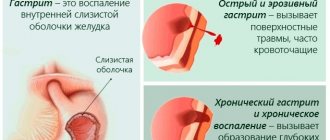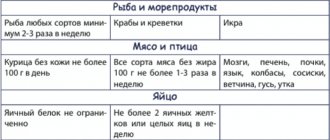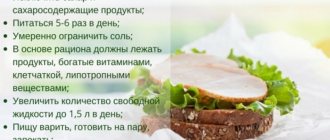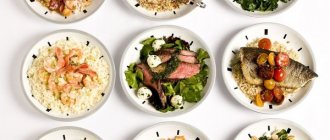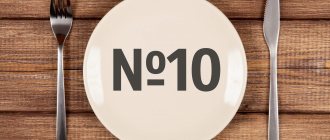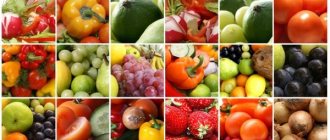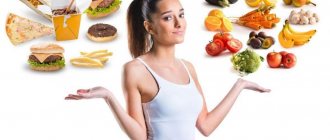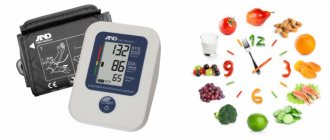Nutrition for pyelonephritis is a specific diet that helps eliminate the inflammatory process in the kidneys, normalizes metabolic processes in the body and serves as a source of strengthening the patient’s immunity.
Bacterial infection of the renal pelvis is a disease called pyelonephritis. The disease is widespread, has acute and chronic forms and several stages of progression. Among its main symptoms are high body temperature, nausea and vomiting, pain in the lumbar region, and urinary disturbances. This pathology can be treated in acute form only in a hospital setting. To improve the impact of drug therapy and increase its effectiveness, the patient is prescribed an appropriate diet in parallel.
Nutrition for acute forms of pyelonephritis should be gentle on the kidneys. At the acute stage, it is recommended to limit protein and salt. In this case, the drinking regime becomes more active, since if an inflammatory process occurs, the kidneys should be washed to reduce the concentration of pathogenic microorganisms in them.
Basic principles
The diet for pyelonephritis in adults suggests that nutrition should not only be balanced, but also dosed. The nutritional value of the foods consumed must be sufficient to support the body depleted by the disease.
Patients with pyelonephritis should follow table No. 7. It is suitable for patients with kidney disease in the absence of chronic renal failure.
Dietary recommendations differ depending on the form of the inflammatory process. Dietary table No. 7 for pyelonephritis is divided into 2 groups:
- No. 7a - diet for acute pyelonephritis (the most gentle for the kidneys);
- No. 7b - nutrition for chronic pyelonephritis.
The basic principles of table 7 are similar, regardless of the subgroup:
- adherence to the regime, eating food at regular intervals, at least 4 times a day;
- exclusion of salt and heavy protein foods from the diet (in the remission stage, up to 10 g of salt per day is allowed);
- daily protein intake – up to 20 g, fat – up to 80 g, carbohydrates – 350 g;
- proper heat treatment of consumed dishes: food can be boiled, steamed, baked, stewed, but not fried;
- reduction of products with harmful chemical composition;
- refusal of alcohol, carbonated drinks, strong tea and coffee;
- exclusion of legumes, pickles, hot seasonings, canned food and smoked meats.
Food should not be fatty, but high in calories and vitamins - no more than 3200 kcal.
The main purpose of the diet for pyelonephritis is to reduce the load on diseased kidneys, as well as to enhance the removal of nitrogenous compounds and excess fluid from the body. Between meals you need to drink clean water, non-acidic juices or compotes, but in small sips.
Nutritional features for pyelonephritis depend on the form of the disease and the age of the patient.
During an attack of acute inflammation on the first day, it is better to completely exclude protein foods from the diet. On day 2 you can eat vegetables and fruits, which have a diuretic effect.
A protein-free diet cannot be followed for more than 2 weeks, otherwise your health will deteriorate significantly. It is necessary to arrange fasting days 1-2 times a week.
A plant-milk diet is indicated for days 7-10. It involves the inclusion of dairy products and cereals in the diet. The maximum permissible daily dose of salt is 3 g. After acute symptoms have decreased, you can move to table No. 7.
With chronic pyelonephritis, it is important not only to eat properly, but also to have a healthy lifestyle. It is necessary to increase the volume of fluid consumed to 2-2.5 liters per day to enhance the filtration activity of the kidneys. In case of acute pyelonephritis, it is necessary, on the contrary, to limit the drinking regime to 1 liter.
Nutrition for acute pyelonephritis
Acute pyelonephritis is a nonspecific inflammatory disease of the kidneys, often encountered in the practice of urologists. Occurs as a result of a bacterial attack. Bacterial agents can enter the kidneys through the blood or from the urinary tract, that is, they can be exogenous or endogenous. The pathological process involves the collecting system and interstitial tissues of the kidneys. Acute pyelonephritis occurs more often in women and young children, which can be explained by the peculiarities of anatomy and physiology.
If the patient consults a doctor in a timely manner and the treatment is correctly prescribed, the course of the acute form of pyelonephritis is favorable. Since antibiotics are the mainstay of treatment for kidney inflammation, surgical intervention is extremely rare. If you carefully follow medical recommendations, the patient will experience a significant improvement in his condition within 2 weeks.
Diet for pyelonephritis in adults with sharp severe pain
- During the first two days of an exacerbation of the disease, the doctor prescribes a sugar and fruit diet. During this period, you need to drink a lot of fluid - up to 2 liters per day. The following drinks are suitable: compote, juice, herbal infusions, sweet weak tea. It is also recommended to consume melons (especially watermelon and melon).
- After the first two days, when the patient’s well-being improves, the patient is prescribed a special diet for pyelonephritis, the key products of which are fresh vegetables, fruits, juices and compotes. Also, for up to 10 days after an exacerbation of the condition, the amount of salt should be reduced to 2 grams per day.
- After ten days (when the patient no longer suffers from pain), lean and properly prepared meat, fish, and cottage cheese are introduced into the diet. At this time, you should not eat fried, spicy, fatty foods, as they can provoke an exacerbation of inflammation. And during the year it is necessary to limit the intake of salted and smoked products.
Disease prevention
Prevention of pyelonephritis requires compliance with several requirements:
- The daily dose of fluid consumed should be at least 3 liters.
- Prolonged retention of urination is not allowed.
- Any infectious diseases cannot be left without attention and treatment.
- Don't get too cold.
- Follow a diet. Eliminate carbonated drinks, smoked foods, pickles, fatty and fried foods from your diet.
- Take multivitamins.
- Lead a healthy lifestyle without bad habits.
Prevention of exacerbations of this disease involves the use of medicinal herbs. The latter should have anti-inflammatory, bactericidal and diuretic properties. It is recommended to eat juniper fruits, parsley roots and leaves, hop cones, birch buds, corn silk, and strawberry leaves.
To avoid exacerbation of the disease, you can drink lingonberry tea. For this, 1 tbsp. l. leaves, pour 200 g of hot water and boil for 10 minutes. Strain and use 3 tbsp. l. 4 times a day. Cranberry juice has good preventive and therapeutic properties, but it can only be consumed during normal urination. The drink is taken 1 glass per day in combination with antibiotics.
Taking various juices has a positive effect: birch, blueberry, strawberry, cabbage, pumpkin and carrot. They not only fill the body with vitamins, but also heal. To prevent exacerbations, you need to follow a diet, take herbal medications and undergo rehabilitation in sanatoriums using mineral water.
Prohibited Products
List of foods that are prohibited for kidney pyelonephritis:
- rich meat, mushroom and fish broths;
- legumes, mushrooms;
- spices, mustard, horseradish, hot sauces, ketchups, mayonnaise;
- salty food;
- fatty meats and fish;
- semi-finished products;
- sausages and smoked meats;
- pickles, marinades, canned food;
- alcoholic and carbonated drinks;
- chocolate.
You need to remove easily digestible carbohydrates from the menu. You cannot eat in restaurants and bistros; you should give preference to home cooking.
All products containing salt are prohibited. These are industrially produced bakery products. Also included in the list of prohibited foods are salted cheeses and all fish (with the exception of fresh frozen).
What not to eat if you have pyelonephritis
Patients with the disease in question need to limit the amount or completely eliminate the consumption of those foods that irritate the kidneys. These include:
- broths and soups based on rich meat and fish broth – we are talking about the so-called “first” broths;
- first courses of legumes;
- salted and smoked fish;
- any fatty varieties of river and sea fish;
caviar of any fish;
- seafood;
- fatty meats;
- lard and interior fat;
- bread with added salt;
- any flour products with added salt;
- mushrooms of any kind and prepared in any way;
- strong tea and coffee;
- chocolate;
- confectionery products (pastry and cakes);
- sorrel and spinach;
- radish and radish;
- onion and garlic;
- sausages and sausages – boiled, smoked, fried and baked;
- any smoked products;
- sharp and fatty cheeses;
- canned meat and fish;
- marinades and pickles;
- high fat sour cream.
Authorized Products
A diet for chronic pyelonephritis in adults involves consuming the following foods:
- fruits, berries and vegetables, especially melons, watermelons, zucchini, cucumbers;
- dairy and fermented milk products, including sour cream, mild cheeses, and butter no more than 20 g per day;
- fish;
- lean meat, poultry;
- eggs (no more than 2 pieces per day);
- cereal porridge;
- pasta;
- vegetable oil;
- honey, marshmallows, jam, preserves;
- homemade freshly squeezed juices, fruit drinks, non-acidic compotes, herbal teas;
- weak tea and coffee, rosehip decoction;
- bread, pancakes and other flour products prepared with yeast, but without salt.
The list of permitted products is supplemented by dairy, sour cream and fruit sweet sauces, and slightly sour sauces.
Instead of salt, you can add pepper, coriander, cumin and other herbs to your food.
Recommended Foods
A strict diet for pyelonephritis, even in the acute stage, is required for the patient only in the first days of the disease. In the future, it is necessary to eat, observing the basic principles of a healthy diet, but not neglecting the variety of foods. Experts recommend including lean types of meat, poultry and fish in your daily menu, which can become a source of animal protein, which must be gradually reintroduced into the diet after strict restrictions. Vegetable, dairy, and cereal soups and porridges are also suitable for the daily diet (buckwheat and oatmeal are the best options). Consuming large amounts of vegetables and fruits, as well as dairy products, has a great effect on the kidneys. Dairy and fruit and vegetable foods help shift the acid-base balance in the urine to the alkaline side, while pathogenic microflora will die even without medications, since it is the acidic environment that is the basis for its vital activity. An alkaline environment in the kidneys will help speed up the healing process.
The main dietary menu for pyelonephritis is calculated for a week. For the first 2-3 days, it is important to consume a lot of herbal infusions and teas, completely eliminating the consumption of sugar. During exacerbations, you can eat unsalted vegetable soups, and later add dairy products to them. Among the most desirable vegetables for pyelonephritis, experts name carrots, zucchini with their high diuretic properties, pumpkin, and potatoes. It is recommended to add watermelons and melons to fruits, which actively cleanse and wash the kidneys. Among the permitted flour products are pancakes and pancakes, as well as crackers made from fresh bread.
When following a diet during exacerbation of pyelonephritis, it is important to drink drinks such as alkaline mineral water, rosehip decoction, dried fruit compote, weak lemon tea, and diluted cranberry juice. Cranberry acid helps suppress the proliferation of pathogenic microbes in the kidneys. If you have pyelonephritis, you should absolutely not drink coffee or alcohol.
Menu for the week
Dietary nutrition should be followed not only during the treatment of pyelonephritis, but also for some time after recovery, until all processes in the kidneys improve.
The menu is selected by the doctor. Since patients with chronic pyelonephritis are often diagnosed with iron deficiency anemia, the diet should contain foods fortified with iron.
Exacerbation stage
The most optimal in the acute stage, as well as in acute inflammatory processes, is a fruit and vegetable diet. This menu should be followed for at least 10 days:
- Monday: milk porridge, green tea, vegetable soup, rice porridge, boiled meat, jelly, potato zrazy, juice.
- Tuesday: stew, tea with milk, borscht, cabbage rolls, pasta seasoned with sour cream sauce, fermented baked milk.
- Wednesday: vegetable puree, kefir, cereal soup, millet porridge, chicken meatballs, cottage cheese casserole with fruit sauce, milk.
- Thursday: omelet, rosehip broth, beetroot, pasta, steamed fish cutlets, vinaigrette, compote.
- Friday: cottage cheese with raisins, tea with lemon, cabbage soup with sour cream, pilaf, vegetable stew with boiled potatoes, yogurt.
- Saturday: casserole, compote, vegetable soup, buckwheat porridge, meatballs, pasta with vegetables, kefir.
- Sunday: fruit puree, tea, milk soup, boiled vegetables, steamed cutlets, baked potatoes, juice.
Remission stage
The menu for the week might look like this:
- Monday: buckwheat porridge with butter, compote, a handful of dried apricots, vegetarian borscht, steamed cutlets, casserole and kefir.
- Tuesday: vinaigrette seasoned with sour cream, tea with milk, salt-free bread, rice soup, steamed fish, baked apple, millet casserole, vegetable stew, dried fruit compote.
- Wednesday: omelet, rosehip broth, curd soufflé, bun with milk, cereal soup, shrimp salad, jelly, rice with vegetables, kefir.
- Thursday: yogurt with berries, biscuits, soup with meatballs, pasta with vegetables, fruit pudding, stew with buckwheat, compote.
- Friday: milk soup, fruit salad, pumpkin soup, chicken soufflé, boiled potatoes, fresh vegetable salad, decoction of medicinal herbs.
- Saturday: vegetable salad, cottage cheese, vegetable borscht, steamed fish cutlets, 200 g of watermelon or melon, pilaf with rabbit, green tea.
- Sunday: sandwich with hard cheese, tea, borscht with sour cream, squash caviar, banana or a handful of berries, baked potatoes with vegetables and meat, lingonberry juice.
At least once a week, patients with chronic pyelonephritis need to have vegetable and fruit fasting days.
Diet for pyelonephritis in pregnant women
If the disease in question is diagnosed in women during pregnancy, then nutritionists develop a slightly different diet for them. It is strongly recommended to include the following products and dishes in the menu of a pregnant woman diagnosed with pyelonephritis:
- boiled chicken without skin;
- whole milk and low-fat cream;
- fermented baked milk and kefir, sour cream and yoghurts with a minimum percentage of fat content;
- dietary bread without salt;
- unsweetened baked goods;
- steamed omelettes, boiled eggs, but no more than 2 times a week;
- boiled or baked fish (remove skin);
- weak black tea with added milk, fruit drinks, fruit and vegetable jelly;
- zucchini, eggplant, cucumbers, carrots, fresh tomatoes;
- apples, pears, grapes;
- some spices - it is allowed to add cloves, parsley, dill, bay leaf and cinnamon to dishes;
- porridge cooked without adding salt.
If a woman diagnosed with pyelonephritis is pregnant, then she needs to exclude spicy, sour, pickled and salty foods, legumes, mustard, cocoa, pastries, sorrel, radishes and spinach from her diet.
Please note: during pregnancy, almost all medications are prohibited for use, so the inflammatory process in the pelvicalyceal part of the kidneys must be “restrained” by diet.
Recipes
Dietary food can be not only healthy, but also tasty. For the first course you can prepare millet soup. You will need 2 tbsp. l. millet, 2 potatoes, 1/2 carrots, greens.
Preparation:
- Cut the potatoes into cubes, carrots into strips.
- Pour into boiling water. Cook for 15 minutes.
- Add millet, cook for 10 minutes.
Season the finished dish with 1 tbsp. l. butter and sour cream.
Pumpkin soup turns out delicious. You will need 300 g of pumpkin, 2 potatoes, 1/2 carrot, onion.
Preparation:
- Bring 1.5 liters of water to a boil.
- Add chopped vegetables.
- Grind the finished soup in a blender.
For the main course, you can prepare a side dish; beef stewed with zucchini will do. Preparation:
- Cut 0.5 kg of beef into cubes and simmer in a small amount of vegetable oil and water.
- Add parsley root and diced carrots to the meat.
- Then add the diced zucchini. Simmer until done.
Season the finished dish with fresh herbs.
To diversify the menu, you can make vegetable cutlets. The main vegetable will be cauliflower; you will need about 700 g of it. You also need to prepare 100 ml of milk, an egg, 1 tbsp. l. semolina and 1 tbsp. l. melted butter.
Preparation:
- Disassemble the cauliflower into inflorescences, pour in milk and 50 ml of water, add butter. Simmer for 10 minutes.
- Add semolina, simmer for 5 minutes.
- Cool the mixture, beat in the egg and knead.
- Form cutlets, roll in breadcrumbs.
- Steam.
You can treat yourself to something sweet by preparing rice porridge with dried fruits. A handful of rice needs to be washed and filled with water twice as much as the cereal. Cook until done. Steam 10 g of raisins and dried apricots in boiling water in advance. Pour dried fruits into hot porridge, add 10 g of butter and sugar. Cover the pan with a lid for 10 minutes.
Dietary diet (menu) for adult patients with pyelonephritis
One-day standard dietary menu for pyelonephritis for adults:
- Breakfast should consist of: grated carrots or apples with olive oil, oatmeal, toast, tea with milk.
- For second breakfast, just drink a glass of freshly squeezed apple juice.
- For lunch, it is advisable to first cook cabbage soup in lean broth with the addition of fresh cabbage. The second - in the form of boiled fish (cod) with a side dish of buckwheat or rice (as an alternative - dietary chicken pilaf), plus cucumber-tomato salad and rosehip compote.
- For an afternoon snack, it is enough to eat 5 large prunes or dried apricots and drink 1 cup of green tea.
- Dinner includes cottage cheese and carrot casserole, finely chopped cabbage salad with a few drops of lemon juice, weak tea with honey. Dinner must be finished before 6 pm.
- Before going to bed, it is useful to drink mint or currant tea.
Consequences of not following the diet
If the diet is not followed, serious complications can occur. The most common:
- paranephritis – inflammation of the perinephric tissue;
- formation of kidney stones;
- foci of necrosis in the kidney;
- sepsis;
- heart damage and heart failure;
- kidney dysfunction;
- renal failure.
When severe kidney damage develops, the only option is hemodialysis, surgery or organ transplantation.
Any kidney disease, including pyelonephritis, can affect the condition of the body as a whole. It is necessary to strictly adhere to all doctor’s recommendations not only regarding treatment, but also nutrition.
Author: Oksana Belokur, doctor, especially for Nefrologiya.pro
What happens if you don’t follow a diet for pyelonephritis?
Many patients with chronic pyelonephritis, unfortunately, ignore the recommendations of a nutritionist and constantly violate the prescribed diet. No, during periods of exacerbation of the inflammatory process, even the most carefree patients remember the need to exclude provoking foods from the menu, but as soon as the disease enters the remission stage and all pronounced symptoms disappear, they allow themselves to relax. It is unlikely that they realize the seriousness of pyelonephritis, because even with a simple violation of the diet, the following complications can arise:
- the inflammatory process begins not only to progress, but also to spread to the tissues surrounding the kidney - this condition is called paranephritis;
- with a probability of up to 87%, stones will begin to form in the patient’s kidneys - pyelonephritis and urolithiasis in tandem pose a threat to human life;
- if, with chronic pyelonephritis, periods of exacerbation of the pathology are recorded too often, then doctors begin to place a high level of risk of developing a carbuncle or abscess in the kidneys - literally purulent melting of the kidney occurs;
- the kidneys work not just with disturbances, but in an unacceptable mode, which can result in renal failure - a condition requiring immediate medical attention, possibly surgical intervention and removal of the affected organ;
- with a constant violation of the diet, toxins accumulate in the body, which can “result” in bacteriotoxic shock - only specialists can remove the patient from it.
Treatment of pyelonephritis that occurs in a chronic form is always long-term; doctors say that a complete recovery is impossible, but the probability of long-term remission of the pathology is very high. In order for the inflammatory process in the pyelocaliceal section of the kidneys to stop its development, it is necessary not only to follow all the prescriptions of the attending physician, to undergo courses of physiotherapy and sanatorium-resort treatment - it is very important to follow the diet and diet.
Tsygankova Yana Aleksandrovna, medical observer, therapist of the highest qualification category.
16, total, today
( 175 votes, average: 4.55 out of 5)
Bladder stones: symptoms and treatment
Cystitis: symptoms, prevention, treatment
Related Posts
Diet rules
Nutrition for pyelonephritis is strict, low-calorie and consists of several stages:
- The point of the first stage is to reduce the load on the affected organs - kidneys, digestive tract, urinary tract, so that drug treatment brings maximum benefit.
- At the second stage, changing the diet helps reduce the intensity of symptoms and improve the child’s overall well-being.
- The third stage is the final one. The diet is expanded as much as possible, bringing the daily calorie content to 2000-2700 kcal. BJU norms are calculated based on the child’s weight: for each kilogram there should be about 3 grams of protein, 3.5 g of fat, 15 g of slow carbohydrates.
Throughout the treatment, the child’s body must receive a sufficient amount of vitamins, minerals, and microelements. It is important to constantly adhere to the basic rules of therapeutic nutrition:
- Small meals - up to 5-6 times a day (3 main meals and 2-3 snacks). Portion sizes are small, about the size of a fist.
- The temperature of served food should not exceed 40 °C. Cold drinks and ice cream are strictly prohibited.
- You can cook food by steaming, stewing, baking using vegetable oils, or boiling.
Antihelminthic drugs for humans - a list of broad-spectrum medications for children and adults Urates in the urine of a child and an adult Red blood cells in the urine of a child - indications for analysis, causes of deviations from the norm and methods of treatment
Drinking regime
In the acute stage of the disease, a teenager should drink up to one and a half liters of water per day, children under 14 years old - 1 liter. The drinking regime for pyelonephritis must be observed throughout the entire treatment. It helps restore kidney function, improve urine flow, and remove harmful substances from the body. It is not necessary to give your child only water; the following are allowed:
- compotes;
- natural vegetable or fruit juices;
- herbal decoctions;
- weak tea;
- rosehip decoction;
- jelly;
- fruit drinks;
- alkaline mineral waters (Borjomi, Narzan, Smirnovskaya).
Limiting salt intake
For pyelonephritis, it is necessary to strictly limit salt intake to 3-6 grams per day. Products with a high content of sodium chloride (canned meat or fish, salted, smoked fish, sauerkraut) are completely excluded from the diet. To improve the taste of dishes, you can add vinegar, lemon juice, and seaweed. In severe forms of the disease, it is recommended to completely exclude salt from the diet.
Its effect on the body
The nutrition has proven itself to be excellent, having proven its effectiveness in practice.
The diet helps reduce inflammation, relieves pain and unpleasant symptoms, and reduces the load on the kidneys , allowing them to recover.
Excess salts and toxins are removed from the body. The blood circulation process is normalized. Gradually the patient's condition returns to normal.
Day by day, the disease will recede, and the patient will recover. It will be possible to avoid complications and recurrence of the disease. It will be possible to maintain kidney health.
Fats: harm or benefit for pyelonephritis
You cannot completely give up fats. It is enough just to refuse frying during the cooking process and eliminate fermented milk products with a fat content above 3-5% from your diet. You should also exclude fatty meats.
But healthy polyunsaturated fats must be present in the diet. You can eat 30-50 grams of nuts per day, about 80-100 grams of salmon fish (they are rich in omega-3 and omega-6), season salads with cold-pressed oils (olive, cottonseed, peanut, flaxseed, sunflower, grape seed).
The use of margarine in cooking is prohibited. Accordingly, all baked goods are prohibited.
What are the benefits of diet
Diet for pyelonephritis plays an important role in the overall treatment of the inflammatory process in the kidneys and urinary tract. Mandatory adherence to the diet leads to the restoration of kidney function, normalizes all metabolic processes, removes metabolic products, and normalizes blood pressure. Proper and regular nutrition can reduce symptoms and speed up treatment, reducing the load on the gastrointestinal tract and kidneys.
- A diet for chronic pyelonephritis in adults is prescribed for a long period (1 year or more) as a prevention of possible exacerbations.
- In case of exacerbation of chronic pyelonephritis, it is imperative to adhere to the rules of diet number 7 in order to avoid severe complications such as urolithiasis, renal failure, and kidney necrosis.
Some patients, when following diet No. 7, experience weight loss as a result of proper, balanced and rational nutrition.
Causes of pyelonephritis in men:
- Chronic foci of infection;
- The presence of concomitant diseases, such as diabetes mellitus, urolithiasis, urethritis, prostatitis, prostate adenoma, AIDS.
Symptoms of pyelonephritis in men:
- Pain in the lumbar region and directly in the kidneys;
- Fever, chills;
- Burning and itching when urinating;
- Increased urine output.
Important! Pyelonephritis is treated in men strictly under the supervision of a doctor.
The need to follow a diet is determined by the severity of the disease and the duration of its treatment.
How long should you follow the diet?
According to experts, even after the disease has subsided, it is necessary to adhere to the diet for at least two more months. This is necessary so that the body has time to cleanse itself and fully recover. To prevent relapses, it is recommended to permanently avoid eating foods such as:
- spicy dishes;
- various seasonings and spices;
- smoked fish and meat products;
- marinades and pickles;
- alcohol.
It is better to accustom yourself to natural products, steamed or boiled, to drink fresh compotes, juices, and fruit drinks.
Once every six months you need to see a specialist, undergo all prescribed examinations and take tests.
The role of nutrition in prevention and treatment
Along with drug treatment, therapy for kidney inflammation includes a special diet. Only by strictly following the doctor’s recommendations and prescriptions can you cope with the disease.
The basis of any diet for this disease is to reduce the content of fats and proteins in the diet. The menu is based on the fact that food should lower blood pressure and help reduce swelling.
The main rule for pyelonephritis, the importance of which is emphasized by all experts, is to consume as little salt, protein and fat as possible. They should prefer vegetable and dairy products.
Berry and fruit smoothies for people with pyelonephritis
Smoothies are another easy dessert for people with kidney problems. You will need low-fat kefir and any fruits and berries (from the list of allowed ones, i.e. we exclude bananas right away).
Mix in a blender (you can use a submersible or regular food processor) two parts kefir to one part fruits and berries. Beat until a homogeneous consistency is formed. After this, the drink should be consumed immediately, if desired, adding ice cubes to it or decorating the glass with a straw or slices of fruit.
Features of the therapeutic diet of an adult
Regardless of age, a diet for kidney pyelonephritis is prescribed by a medical specialist. In men, the disease proceeds according to a slightly different mechanism than in women. This fact is associated with the characteristics of the urinary system. However, the menu concepts are the same. Dishes must be boiled or steamed, no frying, pickling or smoking.
Below are the daily values for the main substances:
- The total volume of liquid, including fruit drinks and compotes, is 2-3 liters.
- Carbohydrates - no more than 450 g.
- Sugar - no more than 90 g.
- Fats - no more than 100 g (25% of the given norm applies to vegetable fats).
- Proteins - no more than 80 g, of which 40 g are of animal origin.
Separately, it should be noted that the consumption of alcohol and carbonated drinks is inadmissible. They greatly provoke acute disease crises. There are also strict regulations regarding baked goods and bread. Baked goods and traditional bread are prohibited. To prepare dietary salt-free bread, wholemeal flour is used.
Daily menu option for pyelonephritis
- Breakfast: egg yolk omelet, unsweetened tea.
- Second breakfast: milk porridge, berry juice.
- Lunch: vegetarian soup, steamed vegetables, dried apple compote.
- Afternoon snack: large apple, herbal decoction.
- Dinner: boiled fish, unsalted rice, beet salad, unsweetened tea.
The daily required fluid intake has been established - at least 1 liter. Daily calorie content is 2200-3000 kcal.
Principles of therapeutic and prophylactic diet for acute and chronic pyelonephritis
The goal of a therapeutic and preventive diet for this kidney pathology is to eliminate inflammation. If you carefully follow your doctor’s advice and adhere to the recommended menu, you can:
- optimize kidney function;
- normalize metabolic processes in the body as a whole;
- reduce swelling;
- reduce blood pressure;
- facilitate the release of end products of metabolic processes, nitrogen compounds, salts, toxic substances, etc.;
- prevent the development of severe complications, including renal failure;
- prevent the pathology from becoming chronic.
If a patient wants to overcome pyelonephritis, he must adhere to the following rules when planning his diet:
- the diet is based on carbohydrates (up to 450 g per day), mainly “slow” (they should account for at least 4/5 of the total carbohydrate content);
- 80 g of protein are allowed daily (half of which can be animal products);
- the daily menu can contain up to 100 g of fat (1/4 of which is of vegetable origin);
- You should maintain an optimal drinking regime, drinking 2 to 3 liters of liquid daily;
- in this case, the consumption of sodium salts should be sharply limited (up to 2 g) or completely switched to a salt-free diet;
- Naturally, pickles, marinades, fast food, semi-finished and finished products that contain any sodium salts are prohibited;
- to optimize kidney function and facilitate excretory function, it is necessary to divide the daily diet into 5 doses;
- for pyelonephritis, any methods of culinary processing are allowed, but fried and smoked foods should be excluded, as they provoke inflammation;
- Drinking alcoholic beverages is not recommended.
Consequences of pyelonephritis for women
Untimely detection and incorrect treatment of pyelonephritis can lead to a chronic form of the disease.
In women, pyelonephritis is more often detected than in men, this is due to the peculiarity of the anatomical structure. The formation and development of the disease is facilitated by various pathologies associated with immune, endocrine, chronic and gynecological problems, as well as with a sharp decrease in the body’s protective background. There are also provocateur diseases that cause inflammation of the kidneys: diabetes mellitus, constant chronic inflammatory processes, as well as various microbes from the environment and diseases associated with the outflow of urine, which creates a favorable environment for the development of infection. In this article we will talk about the possible consequences of pyelonephritis if the diagnosis is delayed and the treatment is incorrect. The folk way to cleanse the kidneys! Our grandmothers were treated using this recipe...
Cleaning your kidneys is easy! You need to add it during meals...
Causes of pyelonephritis
An infection that can cause pyelonephritis can enter in several ways
An infection that can cause pyelonephritis can enter in several ways:
- through the bloodstream, this method is the most common;
- through the lymph flow - from infected places that are located near the intestines or genitals;
- urogenic - moving through infected urine.
Signs that cause pyelonephritis can be divided into:
- General - these include: vitamin deficiency, constant stress, chronic fatigue, a decrease in the body’s protective background, the presence of diseases that can block the body’s protective function;
- Local - the main indicator is a violation of the passage of urine, i.e. the presence of any factors obstructing the normal outflow of urine, for example, narrowing of the ureter, urolithiasis.
Characteristics and symptoms of acute pyelonephritis
The acute form manifests itself suddenly, the patient’s temperature rises sharply
Depending on the course of the pathology, pyelonephritis is divided into two main forms: acute and chronic. The acute form manifests itself suddenly, the patient’s temperature rises sharply, and pain appears in the lumbar and abdominal areas. The pathology is accompanied by symptoms of cystitis, a frequent urge to go to the toilet, as well as pain during urination. In addition to pain, the patient experiences severe headaches, general malaise, weakness, attacks of vomiting and nausea.
For information! The uncomplicated form of pyelonephritis does not have any negative effect on urination, however, the urine has a cloudy color, inclusions of blood and an unpleasant odor.
Chronic inflammation is accompanied by dull and aching pain in the lower back, especially when bending or moving. Common symptoms include the following:
- a sharp increase in body temperature up to 40C degrees;
- chills, heavy sweating;
- decreased appetite;
- frequent attacks of nausea and vomiting;
For information! According to statistics, in children under the age of 5 years, pyelonephritis is detected 4 times more than in the older age group, and girls suffer from this pathology 3 times more than boys.
Characteristics and symptoms of chronic pyelonephritis
Chronic pyelonephritis occurs in 3 stages of inflammation of the kidney tissue
Chronic pyelonephritis occurs in 3 stages of inflammation of the kidney tissue. Features of the stages of the chronic form:
- Stage 1 is accompanied by atrophy of the renal tubules, leukocyte infiltration of the interstitial tissue of the medulla;
- Stage 2 is accompanied by inflammation and damage to the tubules, as well as the death of nephrons and compression of the tubules;
- Stage 3 is accompanied by the replacement of kidney tissue with scar tissue, a reduction in the organ, and the kidney has a wrinkled and lumpy surface.
Inflammatory processes in the organ are divided into several phases of development:
- latent - occurs without any symptoms;
- active - with the manifestation of all symptoms of the disease;
- remission - clinical health, i.e. If the disease does not occur within three years, then the patient has completely overcome pyelonephritis.
Symptoms of chronic pyelonephritis include:
- general malaise, fatigue, weakness;
- attacks of headache;
- proteinuria, bacteriuria, leukocyturia;
- dull pain in the lumbar region;
- attacks of nausea and vomiting;
- increased urge to urinate;
- increase in body temperature up to 38C degrees;
- a sharp increase in blood pressure;
- slight swelling of the face, arms, legs.
For information! An increase in blood pressure may be the only symptom of chronic pyelonephritis in remission.
Treatment of pyelonephritis
Antibiotics are used as medications and are administered to the patient until his condition improves.
The main goal of therapy for kidney inflammation is aimed at eliminating the causative agent of the infection. Antibiotics are used as medications, which are administered to the patient until his condition improves and the pain attacks pass. Before starting treatment, laboratory tests are carried out:
- general blood analysis;
- urine culture;
- test to exclude an allergic reaction to antibiotics.
As a rule, treatment is carried out with bed rest, a special diet and timely intake of medications.
For information! If the examination shows the presence of blockage of the ureter with a stone, as a result of which the normal exit of urine from the kidney is difficult, surgical intervention is performed.
Diet therapy includes a large amount of vitamins, fresh fruits and vegetables, boiled meat, fish and low-fat dairy products. Another recommendation is to restore water balance; to do this, you should drink 2 liters of liquid per day. Normalizing the water balance allows you to avoid excessive concentration of urine and flush the urinary tract.
For information! During the period of exacerbation of chronic pyelonephritis, restrictions are imposed on the use of table salt in a daily dosage of no more than 5 grams.
Physiotherapy is also an effective treatment for chronic pyelonephritis. Typically, physiotherapy includes: electrophoresis, sodium chloride baths, ultrasound, galvanization and SMT therapy. If the patient develops uremia, hemodialysis is prescribed. An advanced form of chronic pyelonephritis that cannot be treated requires nephrectomy (removal of an organ), provided that there is unilateral shrinkage of the kidney and arterial hypertension.
Consequences of kidney inflammation
If doctors' recommendations are not followed, renal failure may develop.
Pyelonephritis does not go away on its own, most often its stages transform into each other and as a result, a chronic form occurs. If doctors' recommendations are not followed, kidney failure may develop and even death may occur. Pyelonephritis and its consequences:
- Exacerbation of the disease. During the period when the body’s protective background decreases, the disease worsens and its symptoms become more pronounced;
- The appearance of renal failure. The constant presence of infection in the kidney tissue leads to the death of nephrons, as a result of which the patient will not be able to do without an “artificial kidney” apparatus and hemodialysis;
- Risk of cancer formation. Nephrologists and oncologists still cannot explain the relationship between chronic pyelonephritis and cancer, however, this category of patients is at risk;
- The formation of urolithiasis due to urate deposits in the pelvic tissue, the release of which is almost impossible;
- The formation of acute renal failure, leading to death.
The consequences of pyelonephritis are quite serious; if you do not follow the recommendations of specialists, you can not only worsen your health, but also lose your life. Do not ignore the advice of doctors, undergo timely diagnosis and medical examination.
Approximate diet
Based on the list of allowed/prohibited foods, you can create a menu for your child for a week or several days. Approximate diet for two days:
| Breakfast | Lunch | Dinner | Afternoon snack | Dinner | Snack | |
| 1 day | Semolina porridge with milk, weak tea. | One boiled egg. | Mashed potatoes, steamed turkey meatballs, vegetable soup with sour cream. | Homemade compote, baked apple with honey. | Rice porridge, steamed fish. | A glass of kefir, dietary cookies. |
| Day 2 | Buckwheat porridge with milk, cranberry juice. | Curd pudding with carrots. | Pasta with vegetables, weak tea, bread. | Fruit soufflé. | Boiled chicken fillet, vinaigrette, sandwich with tomatoes and cheese. | Cottage cheese with sour cream and honey. |
The importance of a balanced diet
For more effective recovery, it is necessary to adhere to a certain eating regimen. You may have to deny yourself something. The other extreme should also be avoided: fasting is contraindicated for kidney disease. Nutrition for pyelonephritis should be regular and correct. You need to achieve the following:
- reduce the amount of fats and proteins;
- get the right amount of fluid every day;
- remove urine, toxins and other harmful compounds more intensively;
- reduce salt intake;
- increase the volume of products that can alkalize;
- normalize blood pressure;
- reduce the load, etc.
Drinking nuance
First of all, if a child is diagnosed with pyelonephritis, you should consider not the menu, but the drinking regime. Already from the first day of an exacerbation, you should drink a lot of fluid - translated into ordinary figures, the norm of fluid consumed per day is about 2 liters. It can be reduced only in cases where the child has medical contraindications for this.
Taking fluids helps flush the urinary canals, removes toxins from the body (this is quite important in the presence of inflammation), and replenishes water lost in the body. An excellent solution for restoring water balance would be black or green tea, but only weakly brewed, tea with milk, juices, compotes, decoctions, for example, from rose hips, liquid jelly and even mineral water. An excellent solution would be lingonberry and cranberry juices, which contain a high content of benzoic acid, which inhibits the growth of microbes.
Recommendations from nutritionists, lifestyle, drinking regime
In addition to diet, in case of acute and chronic pyelonephritis, it is necessary to observe a drinking regime.
You need to drink more than 2 liters of fluid . It is consumed not only during meals, but also between meals.
They help remove toxins, harmful bacteria and salts from the body. In addition to water, berry infusions, fruit drinks, and medicinal teas are allowed.
Lifestyle should not be too active during this period. Intense physical activity can aggravate the condition.
Instead of training, it is better to take a walk in the fresh air.
You should get enough sleep, rest and dress warmly . Hypothermia will slow down the recovery process.
